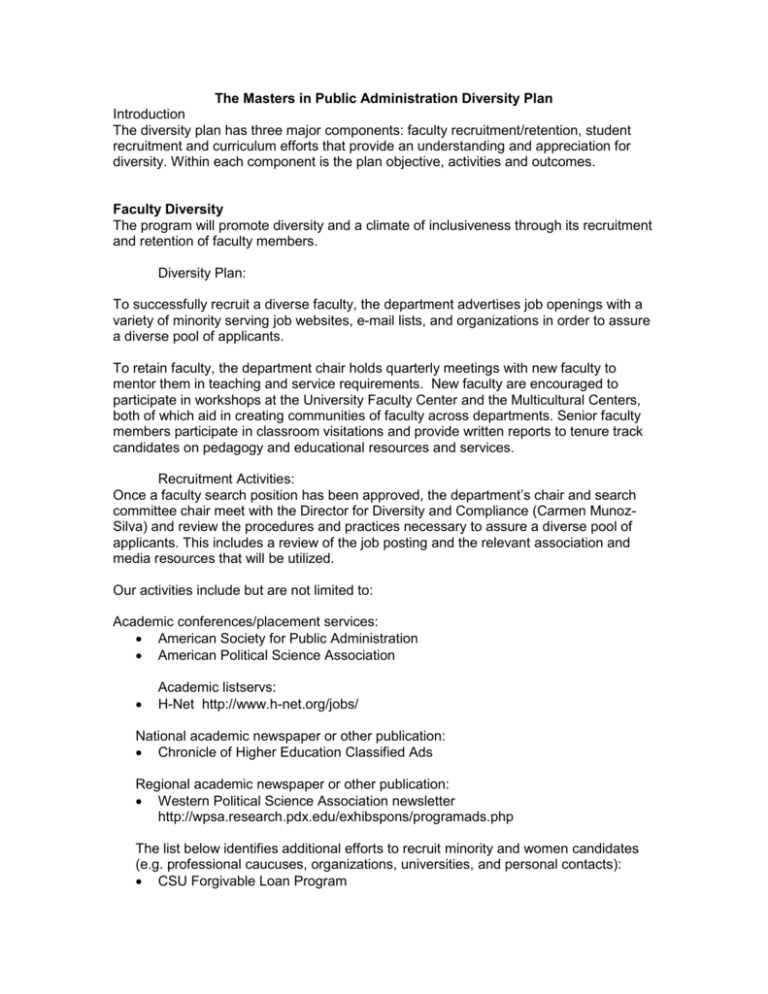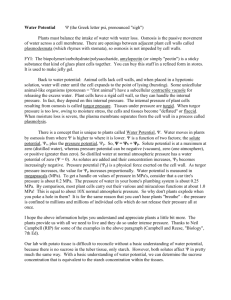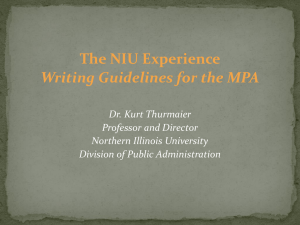The Masters in Public Administration Diversity Plan Introduction The
advertisement

The Masters in Public Administration Diversity Plan Introduction The diversity plan has three major components: faculty recruitment/retention, student recruitment and curriculum efforts that provide an understanding and appreciation for diversity. Within each component is the plan objective, activities and outcomes. Faculty Diversity The program will promote diversity and a climate of inclusiveness through its recruitment and retention of faculty members. Diversity Plan: To successfully recruit a diverse faculty, the department advertises job openings with a variety of minority serving job websites, e-mail lists, and organizations in order to assure a diverse pool of applicants. To retain faculty, the department chair holds quarterly meetings with new faculty to mentor them in teaching and service requirements. New faculty are encouraged to participate in workshops at the University Faculty Center and the Multicultural Centers, both of which aid in creating communities of faculty across departments. Senior faculty members participate in classroom visitations and provide written reports to tenure track candidates on pedagogy and educational resources and services. Recruitment Activities: Once a faculty search position has been approved, the department’s chair and search committee chair meet with the Director for Diversity and Compliance (Carmen MunozSilva) and review the procedures and practices necessary to assure a diverse pool of applicants. This includes a review of the job posting and the relevant association and media resources that will be utilized. Our activities include but are not limited to: Academic conferences/placement services: American Society for Public Administration American Political Science Association Academic listservs: H-Net http://www.h-net.org/jobs/ National academic newspaper or other publication: Chronicle of Higher Education Classified Ads Regional academic newspaper or other publication: Western Political Science Association newsletter http://wpsa.research.pdx.edu/exhibspons/programads.php The list below identifies additional efforts to recruit minority and women candidates (e.g. professional caucuses, organizations, universities, and personal contacts): CSU Forgivable Loan Program Black organizations, colleges, universities Minority and Women Doctoral Directory The National Registry of Diverse and Strategic Faculty at Texas Tech University[http://www.theregistry.ttu.edu/] Diversity site for the Association of American Colleges and Universities [http://www.diversityweb.org/] The Black Ivy Alumni League [www.theleagueonline.org/jobvault1.php] Historically Black Colleges and Universities [http://www.hbcuconnect.com/] NASPAA and ASPA Committees/Sections depending on the area of specialization: budget and finance, nonprofit management, research methods, etc. Faculty retention activities: - - - - The department chair holds quarterly meetings with new faculty to mentor them in teaching and service requirements. Senior faculty complete classroom visits twice each academic year and provide written statements regarding their observations of junior faculty sessions: syllabus, assignments, classroom demeanor, and student interactions. The senior faculty members use this opportunity to encourage practices that are effective and suggest practices that may enhance teaching effectiveness. In addition, each course has student evaluations completed at the end of the quarter. This information is reviewed by the tenure-track candidate and examined by the senior faculty as part of the retention, tenure and promotion process. This data provides an opportunity for senior faculty to share ideas and approaches that have worked well with young scholars in related classes. Senior faculty members comment on the scholarly productivity of candidates and recommend conferences and university resources that are available to support research and creative activities, such as research and creative activity grant opportunities. Senior faculty may suggest publication strategies. New faculty are encouraged to participate in workshops and events at the University Faculty Center and the Multicultural Centers, both of which aid in creating communities of faculty across departments. Participation in campus workshops and related events can be used for evidence of service to the community in the retention and tenure process. Evidence: - Evidence of the success of the program in supporting a diverse environment: The MPA faculty itself is diverse. The faculty is composed of three women, one of whom is Chinese, one African American male, and one Caucasian male. One faculty member’s research engages issues of racial discrimination. Full Time Dedicated MPA Faculty 5 100% Male 2 40% Female Minority 3 60% Non-Minority 2 40% 3 60% Success is realized when junior faculty are presenters at scholarly conferences and make use of the university and college’s travel fund and research grants provided by Office of Research and Sponsored Programs. Student Diversity Diversity Plan The program participates in recruitment efforts to reach out to minorities, women, veterans and other underrepresented groups. Activities Among the efforts the program participates in is: Ongoing collaboration and coordination with the Graduate Admissions and Outreach (GAO) Office (Victoria Ortiz) to facilitate candidates’ completion of applications and to keep the GAO current on the program’s guidelines and objectives. In addition we provide the Graduate Studies Office (Rebecca Rivas) with brochures to foster the recruitment of a diverse and well qualified MPA applicant pool. The MPA faculty members teach courses in the undergraduate political science program. This enables MPA faculty to recruit diverse and qualified students from among the department’s undergraduate population. In addition, Dr. Reese involves undergraduate and graduate students in the Prison Education Project (PEP) which guides former inmates to be educated and productive members of society. PEP has demonstrated the significant influence that a program of this nature may have on reducing recidivism (http://www.prisoneducationproject.org/). The PEP project serves to inspire a broad and diverse community of undergraduates to pursue educational opportunities and careers in public service and public policy. California Forum for Diversity in Graduate Education –held each spring. In 2014 the event will be hosted by Cal Poly Pomona on April 26. In addition the program includes the oversight committee (MiPAAC) in efforts to recruit and retain qualified MPA students. MIPAAC members work locally in the field of public policy and administration and are able to encourage potential candidates in public service to enhance their skills and broaden their service opportunities by enrolling in a Masters in Public Administration Program at CPP. The MiPAAC board is comprised of: Members 15 100% Male 7 47% Female 8 53% Minority 5 33% Non -Minority 10 66% Evidence Women are well represented in the program’s population and among its graduates. The same can be said for minorities (Hispanics, African Americans, Asian and Pacific Islanders). Minority populations comprise 65% of our MPA graduates and 57% of our student population. Graduates of MPA Program: Study Year and SY-1 Year Total Males Females Ethnic Minority 2010-11 22 7 15 18 2011-12 18 9 9 08 All years 40=100% 40% 60% 65% Source: CPP alumni office Student Population: Study Year and SY-1 Year Total Males Females Ethnic Minority 2010-11 56 21 35 31 2011-12 59 28 31 35 All years 115=100% 43% 57% 57% Source: Bronco Direct: Fall 2010 and fall 2011 Enrollment Non-Minority 04 10 35% Non-Minority 25 24 43% Curriculum Efforts: Cultural Competency Diversity Plan To successfully retain a diverse student body, we believe it is important to have a diverse faculty. Minority and women students often report that minority and women faculty serve as important role models for them. Second, the program seeks to increase student exposure to a variety of perspectives by bringing guest speakers to campus at least once a year. Activities This year former U.S. Labor Secretary Hilda Solis came and spoke to students and alumni of the program about her experiences as a Latina woman elected official and administrator in the public sector. Class work is also devoted to issues of discrimination and diversity. The Human Resources class has included the following practitioners in demonstrating professionalism and diversity: Gwen Urey: CFA – Union representative John Sewell: LAPD (African American officer) Tyee Griffith: LGBT Coalition (African American) In the MPA 500 class students are introduced to minorities and women in the MPA profession including: Ms. Tunggaldjaja (current MPA student) – City of Rancho Cucamonga Ms. Menkus (administrator retired)- City of Los Angeles Ms. Tesoro (practitioner) - Los Angeles World Airport Ms. Streeter (practitioner)- Los Angeles World Airport In MPA 505 Qualitative Methods students are introduced to ethnographic research methods which provide a systematic basis for understanding and appreciating cultural diversity. Cleveland Hayes (author of There Is No Culturally Responsive Teaching Spoken Here: A Critical Racial Prospective for the Journal of Democracy and Education) led the MPA 505 section discussion on ethnography in spring of 2013. Evidence The evidence and assessment of the diversity program’s effectiveness is a balance by gender and by minority representation in the program student population and alumni. See Student Diversity: Evidence chart summarized above. Summary The diversity plan, activities, and outcomes are consistent with the mission and goals of CPP's MPA program. Our mission is: To provide an academic and professional graduate education to people preparing themselves for careers in public affairs and/or administration. Specifically this effort is part of goals 4 and 5: · To promote the public interest and articulate and apply a public service perspective · To serve diverse populations and needs. These goals are realized by having a diverse and robust faculty, student and alumni population and curriculum specialists who contribute to our overall program.







